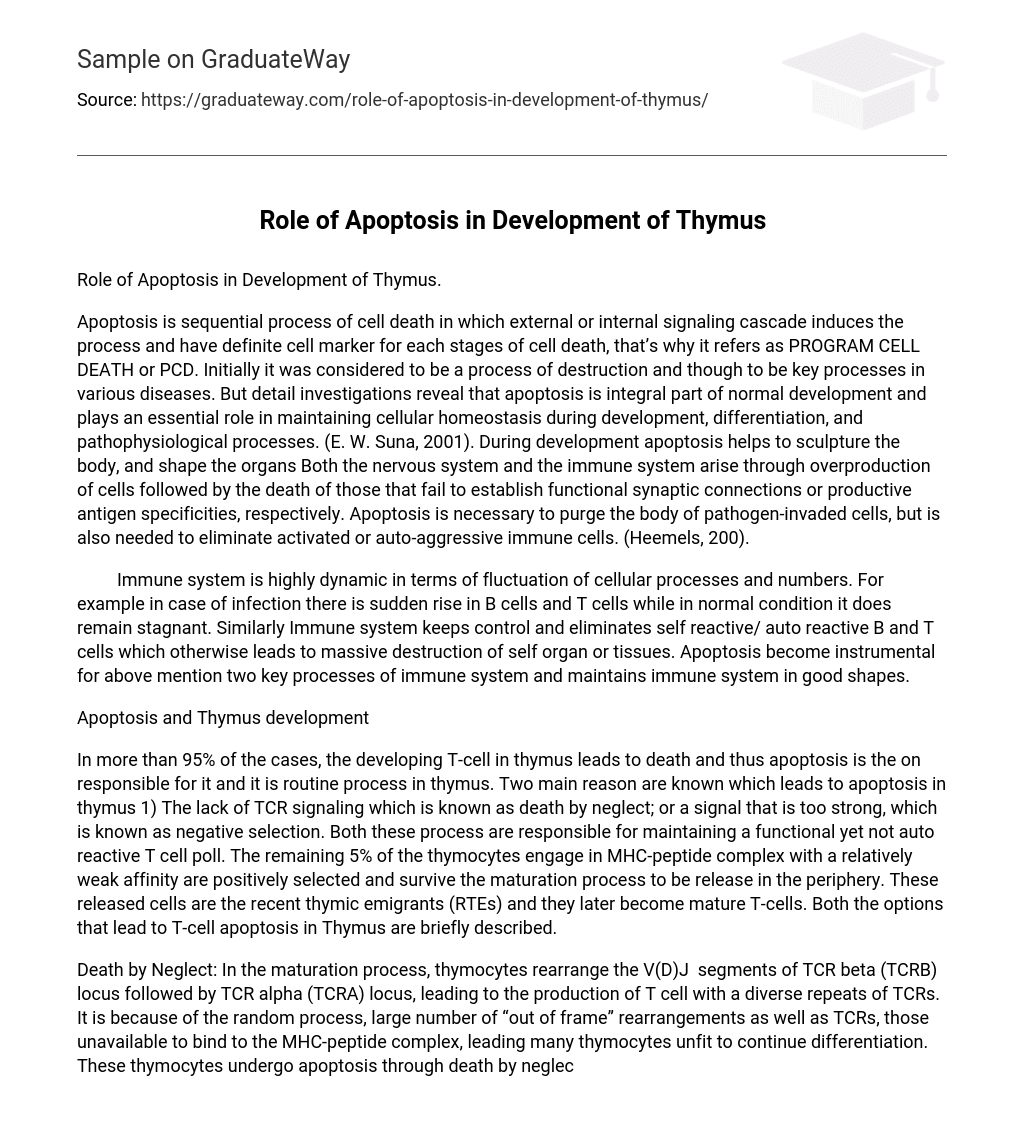Apoptosis is a sequential process of cell death in which external or internal signaling cascade induces the process and have a definite cell marker for each stage of cell death, that’s why it refers as Program Cell Death or PCD. Initially it was considered to be a process of destruction and thought to be key processes in various diseases. But detail investigations reveal that apoptosis are an integral part of normal development and plays an essential role in maintaining cellular homeostasis during development, differentiation, and pathophysiological processes. (E.W. Suna, 2001). During development, apoptosis helps to sculpture the body, and shape the organs Both the nervous system and the immune system arise through overproduction of cells followed by the death of those that fail to establish functional synaptic connections or productive antigen specificities, respectively. Apoptosis is necessary to purge the body of pathogen-invaded cells, but is also needed to eliminate activated or auto-aggressive immune cells. (Heemels, 200).
The immune system is highly dynamic in terms of fluctuation of cellular processes and numbers. For example, in case of infection, there is a sudden rise in B cells and T cells while in normal condition it does remain stagnant. Similarly Immune system keeps control and eliminates self reactive/ auto reactive B and T cells which otherwise leads to massive destruction of self organ or tissues. Apoptosis becomes instrumental for above mention two key processes of the immune system and maintains immune system in good shapes.
Apoptosis and Thymus Development
In more than 95% of the cases, the developing T-cell thymus leads to death and thus apoptosis is the responsible for it and it is a routine process in thymus. Two main reasons are known which leads to apoptosis in thymus 1) The lack of TCR signaling which is known as death by neglect; or a signal that is too strong, which is known as negative selection. Both these processes are responsible for maintaining a functional yet not auto reactive T cell pole. The remaining 5% of the thymocytes engage in MHC-peptide complex with a relatively weak affinity are positively selected and survive the maturation process to be released in the periphery. These released cells are the recent thymic emigrants (RTEs) and they later become mature T-cells. Both the options that lead to T-cell apoptosis in Thymus are briefly described.
Death by Neglect: In the maturation process, thymocytes rearrange the V(D)J segments of TCR beta (TCRB) locus followed by TCR alpha (TCRA) locus, leading to the production of T cell with a diverse repeats of TCRs. It is because of the random process, a large number of “out of frame” rearrangements as well as TCRs, those unavailable to bind to the MHC-peptide complex, leading many thymocytes unfit to continue differentiation. These thymocytes undergo apoptosis through death by neglect, due to no signal from the pre-TCR or from the TCR. DR and extrinsic pathway are responsible for death by neglect. (Badley, 2006)
Negative selection: Negative selection occurs when there is a high affinity occurrence MHC and self-peptide complexes. DR or extrinsic pathway is not responsible by negative selection. Intrinsic pathway plays a critical role in this selection process. The role of antiapoptotic protein Bcl-2 is not involved. While over expressing, Bcl-2 protects the immature thymocytes and thus it decreases considerably in mature SP thymocytes. In a nutshell the whole process occurs when the double negative thymocytes that do not express a functional TCR undergo PF by death by neglect. Once they mature into CD 4+ CD8+ double positive thymocytes and then express TCR, even if there is an absence of TCR signaling, there will be death by neglect. When the TCR has a weak affinity there is DP cell survival and differentiation into single positive mature thymocytes. At this time the high affinity selection of MHC-peptide complex results leads to negative selection, leading to deletion of T-cell clones. (Badley, 2006)
Bibliography
- Badley, A. D. (2006). Cell death during HIV infection. CRC Press.
- E. W. Suna, Y. F. (2001). Apoptosis: the quiet death silences the immune system. Pharmacology & therapeutics, 135-145.
- Heemels, M.-T. (200). Apoptosis. Nature Insight.





